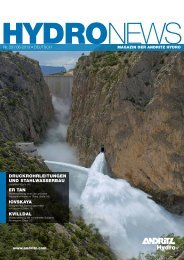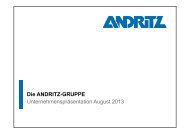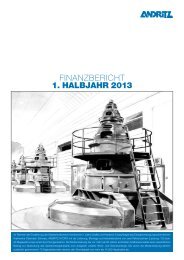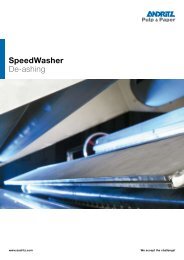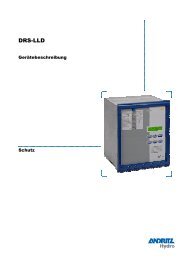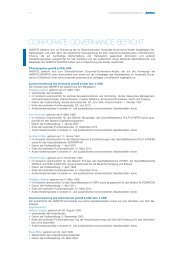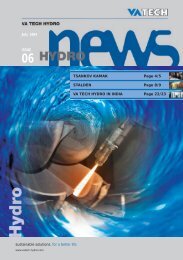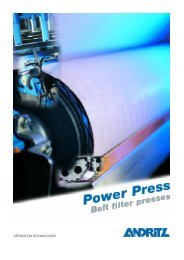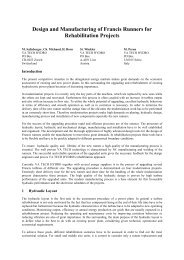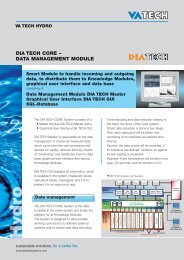FiberSpectrum - ANDRITZ Vertical volute pumps
FiberSpectrum - ANDRITZ Vertical volute pumps
FiberSpectrum - ANDRITZ Vertical volute pumps
Create successful ePaper yourself
Turn your PDF publications into a flip-book with our unique Google optimized e-Paper software.
▲ Linked over the Internet to Veracel’s OPP system 2500 km away, Daniel Schuck, Automation Consultant<br />
with Sindus Andritz, confers with Marcelo Verlings at the mill about the next steps to take in tuning a bad<br />
control loop.<br />
action remotely ourselves. The mill<br />
operators must be involved and take<br />
the action as they are the owners of the<br />
process.”<br />
Ultimately, the best control is based<br />
upon knowledge and experience.<br />
“Things we take into account include<br />
what the process is physically able to<br />
achieve, how this fits into the bigger<br />
safety and profitability picture, the<br />
impact on downstream processes,<br />
and what management has planned,”<br />
Schuck says. “OPP has tools built-in to<br />
help with this where we, together with<br />
the mill, rate the importance of each<br />
loop in terms of its contribution to safety<br />
and economics.”<br />
Side-by-side<br />
In Veracel’s case, Schuck used the<br />
OPP software to analyze about 150<br />
control loops in the bleach plant in one<br />
week.<br />
Fiberline team operators at Veracel<br />
were involved every step of the way.<br />
“When Sindus Andritz identified the<br />
problem loops, we had team meetings<br />
with our operators to get their input and<br />
to involve them in finding the correct<br />
solutions,” Aguilar explains.<br />
“To get optimal control, all the components<br />
must work together properly,”<br />
Schuck says. “For the problem loops,<br />
we had to verify that each component –<br />
control device, sensor, actuator, controller,<br />
and software – was operating<br />
properly and that the design was ap-<br />
22<br />
propriate. We worked side-by-side with<br />
the operators to do this.”<br />
According to Aguilar, “For some loops,<br />
it was a simple fix like repairing a sticking<br />
valve or replacing a bad transmitter.<br />
Others required analyzing the loop’s<br />
overall objective. For example, we<br />
found that one controller was cycling a<br />
valve 100 times per hour. By slowing<br />
the loop to reduce noise as well as<br />
interaction with other control loops we<br />
were able to achieve smoother, more<br />
coordinated production.”<br />
With the help of OPP, Schuck and his<br />
team from Sindus Andritz identified 12<br />
valves with problems, 32 control loops<br />
that required tuning, and eight loops<br />
that needed a different control strategy.<br />
Schuck explains, “One problem that<br />
Veracel was having was unstable high<br />
pressure in the feed to the DD washers,<br />
which triggered interlocks that shut<br />
down the system. After analyzing the<br />
loops with OPP, we felt that the location<br />
of the measurement points and the<br />
programmed action of the controllers<br />
was contributing to the problem. We<br />
discussed this with Veracel and with<br />
the Andritz equipment experts and<br />
reconfigured the control logic. Things<br />
improved dramatically.”<br />
According to Aguilar, the next targets<br />
for OPP are oxygen delignification<br />
and the screening areas. “We hope<br />
to make similar improvements in each<br />
area as we move down the line,” he<br />
says.<br />
Veracel Celulose<br />
Much to be gained<br />
There is much to be gained by optimizing<br />
control loops. It has been estimated<br />
that 80% of process control loops are<br />
causing more variability running in<br />
automatic mode than in manual. An<br />
often quoted study by EnTech showed<br />
that some 30% of all loops oscillate<br />
because of poor controller tuning.<br />
With a poorly tuned loop, an upset in<br />
the process results in waste – causing<br />
off-spec production or over-consuming<br />
expensive raw materials.<br />
The OPP service also provides data<br />
to Veracel about how tuning changes<br />
with time. That’s important, Schuck<br />
stresses, because “one of the most<br />
critical things we do is to stay apprised<br />
of the variability in process conditions.<br />
This is not a one-shot deal, but an<br />
ongoing service we offer. I can have a<br />
one-screen view of overall equipment<br />
efficiency and, seconds later, drill down<br />
to the current tuning parameters of a<br />
specific control loop.”<br />
The OPP software also includes online<br />
tools for alarms, motors, valves, and<br />
analyzer management. An interesting<br />
offline tool, according to Schuck, is the<br />
ability to simulate electrical maneuvers.<br />
“This is a very useful tool for safety,<br />
training, and documentation of the mill’s<br />
electrical systems.”<br />
As an added bonus, OPP can be accessed<br />
remotely. Schuck demonstrates<br />
this capability from his desktop in Sindus<br />
Andritz’s Porto Alegre office (2500<br />
km from the Veracel mill). A few<br />
keystrokes to establish a secure connection<br />
and he is viewing real-time<br />
status information from the mill’s DCS.<br />
Two more mouse clicks and he has a<br />
summary of the loops that are in need<br />
of attention. One more click and he<br />
has the tuning data on a troubled loop.<br />
Within seconds, he is on the phone to<br />
a technician in the mill’s control room,<br />
and the optimization continues…<br />
►► find out more at<br />
www.fiberspectrum.andritz.com<br />
▲ A technician assembles an analyzer in the<br />
Sindus Andritz workshop. Sindus Andritz<br />
manufactures all kinds of devices for gas analysis,<br />
integrating the total system (sensor, sample<br />
handling, and system electronics).<br />
▲ Luis Binotto, President of Sindus Andritz.<br />
Sindus Andritz<br />
In June 2007, Andritz acquired a 50%<br />
stake in Sindus Human Technology,<br />
a company specializing in maintenance<br />
services for pulp, paper, and<br />
other industries in Brazil. “We see<br />
many ways to cooperate and there<br />
are many synergies,” says Luis<br />
Binotto, President of Sindus Andritz.<br />
An electronics engineer and chemical<br />
technician by training, Binotto<br />
was working at a corrosion laboratory<br />
near his home in Porto Alegre<br />
(in the southernmost state of Brazil).<br />
It was 1987 when he, four other engineers,<br />
and a brother-in-law with an<br />
administrative background ventured<br />
out on their own and formed Sindus<br />
Human Technology.<br />
“Our initial business was the<br />
maintenance of complex laboratory<br />
equipment such as chromatographs,<br />
spectrometers, etc.,” Binotto<br />
explains. “Later, we developed<br />
microprocessor-based systems for<br />
controlling the lab equipment.”<br />
In 1989, Sindus was asked by a customer<br />
to develop a gas analyzer for<br />
environmental monitoring – the TRS<br />
analyzer. Today, it is the only manufacturer<br />
of TRS analyzers in Brazil<br />
and has around 100 units operating.<br />
Sindus saw an opportunity and<br />
moved into maintenance outsourcing<br />
of instrumentation and control<br />
systems in 1992. Outsourced maintenance,<br />
Binotto explains, is different<br />
than maintenance contracting<br />
or providing technical assistance.<br />
“When a customer outsources their<br />
maintenance to you, they are relying<br />
on you to manage the maintenance,<br />
not just provide manpower,” he<br />
says. “They ask us to recruit and<br />
train the specialists, schedule the<br />
work, and perform it. Sometimes<br />
they turn their staff over to us and<br />
their people become Sindus employees.<br />
“This is one of our key advantages<br />
of interest to Andritz,” Binotto says.<br />
“We are in the mills all the time doing<br />
maintenance and we are always<br />
on-call for emergency repairs. Our<br />
customers know us and trust us<br />
– and we know their needs and priorities<br />
very well.”<br />
Sindus Andritz today has about 650<br />
employees. 15 key site managers<br />
are located close to customers all<br />
around Brazil. The company has 12<br />
major contracts in force and works<br />
with all the leading pulp and paper<br />
producers. In general, pulp and<br />
paper accounts for about 80% of<br />
Sindus Andritz’s annual revenue.<br />
The rest comes from other process<br />
industries such as steel, chemicals,<br />
and mining.<br />
23



